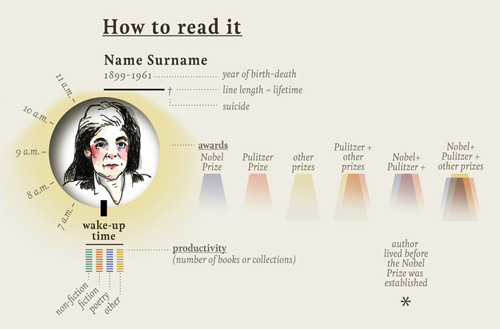Famous Writers’ Sleep Habits vs. Literary Productivity, Visualized
by Maria Popova
The early bird gets the literary worm … sort of.
 “In both writing and sleeping,” Stephen King observed in his excellent meditation on the art of “creative sleep” and wakeful dreaming, “we
learn to be physically still at the same time we are encouraging our
minds to unlock from the humdrum rational thinking of our daytime
lives.”
“In both writing and sleeping,” Stephen King observed in his excellent meditation on the art of “creative sleep” and wakeful dreaming, “we
learn to be physically still at the same time we are encouraging our
minds to unlock from the humdrum rational thinking of our daytime
lives.”Over the years, in my endless fascination with daily routines, I found myself especially intrigued by successful writers’ sleep habits — after all, it’s been argued that “sleep is the best (and easiest) creative aphrodisiac” and science tells us that it impacts everything from our moods to our brain development to our every waking moment. I found myself wondering whether there might be a correlation between sleep habits and literary productivity. The challenge, of course, is that data on each of these variables is hard to find, hard to quantify, or both. So I turned to Italian information designer Giorgia Lupi and her team at Accurat — who make masterful visualizations of cultural phenomena seemingly impossible to quantify — and, together, we set out to explore whether it might be possible to visualize such a correlation.
First, I handed them my notes on writers’ wake-up times, amassed over years of reading biographies, interviews, journals, and other materials. Many came from two books — Daily Rituals: How Artists Work by Mason Currey and Odd Type Writers: From Joyce and Dickens to Wharton and Welty, the Obsessive Habits and Quirky Techniques of Great Authors by Celia Blue Johnson — as well as from the Paris Review interviews and various collections of diaries and letters.
We ended up with a roster of thirty-seven writers for whom wake-up times were available — this became the base data set, around which we set out to quantify, then visualize, the literary productivity of each author.
One important caveat is that there is an enormous degree of subjectivity in assessing a literary — or any creative — career, but since all information visualization is an exercise in subjective editorial judgment rather than a record of Objective Truth, we settled on a set of quantifiable criteria to measure “productivity”: number of published works and major awards received. Given that both the duration and the era of an author’s life affect literary output — longer lives offer more time to write, and some authors lived before the major awards were established — those variables were also indicated for context.

Lastly, I reached out to Wendy MacNaughton — illustrator extraordinaire and very frequent collaborator — and asked her to contribute an illustrated portrait for each of the authors.
The end result — a labor of love months in the making — is this magnificent visualization of the correlation between writers’ wake-up times, displayed in clock-like fashion around each portrait, and their literary productivity, depicted as different-colored “auras” for each of the major awards and stack-bars for number of works published, color-coded for genre. The writers are ordered according to a “timeline” of earliest to latest wake-up times, beginning with Balzac’s insomniac 1 A.M. and ending with Bukowski’s bohemian noon.
The most important caveat of all, of course, is that there are countless factors that shape a writer’s creative output, of which sleep is only one — so this isn’t meant to indicate any direction of causation, only to highlight some interesting correlations: for instance, the fact that (with the exception of outliers who are both highly prolific and award-winning, such as like Bradbury and King) late risers seem to produce more works but win fewer awards than early birds.
Pore over (click the image to zoom) and delight in drawing your own conclusions or merely in taking some voyeuristic enjoyment:

The visualization is available as a gorgeous giclée print, with a third of the proceeds donated to literacy nonprofit Room to Read and the rest split between Accurat and Wendy.
Nessun commento:
Posta un commento
Salve, donatemi un pò dei Vostri Pensieri: